View in other NatureServe Network Field Guides
NatureServe
Montana
Utah
Wyoming
Idaho
Wisconsin
British Columbia
South Carolina
Yukon
California
New York
Lemhi Beardtongue - Penstemon lemhiensis
State Rank Reason (see State Rank above)
Penstemon lemhiensis is a regional endemic that occurs only in southwest Montana and adjacent Idaho. There are numerous occurrences in Beaverhead and Ravalli Counties with a few additional occurrences located in Deer Lodge and Silver Bow Counties in Montana, but most are small to moderate in size. The number of plants in Montana is estimated at approximately 10,000 individual plants based on recent survey efforts. Plants occur on a mix of federal, state and private ownerships with National Forest lands supporting the majority of the occurrences. The species is primarily sensitive to negative impacts associated with drought conditions and fire suppression, both of which are believed to have played a significant role in the species' decline. Additional impacts to populations are occurring from noxious weed invasion, primarily spotted knapweed in the Bitterroot region. Heavy livestock grazing also negatively impacts the species. Several occurrences are found adjacent to roadsides and thus may be impacted by activities associated with road construction, maintenance and use.
- Details on Status Ranking and Review
Population Size
Score1 - Moderate: Generally 10,000-100,000 individuals.
Range Extent
Score3 - Local Endemic or Very Small Montana Range: Generally restricted to an area <10,000 sq. miles (equivalent to the combined area of Phillips and Valley Counties) or <6 Sub-basins (4th code watersheds) Range-wide OR limited to one Sub-basin in Montana
Area of Occupancy
Score0 - High: Occurs in >25 Subwatersheds (6th Code HUC’s).
Environmental Specificity
Score1 - Moderate: Species is restricted to a specific habitat that is more widely distributed or to several restricted habitats and is typically dependent upon relatively unaltered, good-quality habitat (C Values of 5-7).
Trends
Score1-2 - Minor to Moderate Declines:
CommentDeclines have occurred at some locations based upon limited monitoring data. The severity of the declines across the species' range in Montana is uncertain. Additionally, the species has occupied some anthropogenic habitats such as roadcuts.
Threats
Score2 - High: 31-70% of the populations are being negatively impacted or are likely to be impacted by one or more activities or agents, which are expected to result in decreased populations and/or habitat quality and/or quantity.
CommentInvasive species are a problem at some sites or have the potential to become a problem in the near future. Lack of natural disturbance, primarily due to fire suppression appears to be a primary factor in the decline of the species at some locations.
Intrinsic Vulnerability
Score1 - Moderate Vulnerability: Specific biological attributes, unusual life history characteristics or limited reproductive potential makes the species susceptible to extirpation from stochastic events or other adverse impacts to its habitat and slow to recover.
CommentSeed germination and seedling survival appear to be highly dependent upon appropriate soil moisture.
Raw Conservation Status Score
Score
9 to 10 total points scored out of a possible 19.
General Description
Lemhi beardtongue is a large perennial, with 1 to several stems reaching 70 cm in height and arising from a branched rootstock and short taproot. The leaves are narrowly lance-shaped and untoothed. Stalks of the basal leaves are up to 16 cm long, while the opposite stem leaves lack stalks and become smaller up the stem. Herbage is lightly covered with small hairs and occasionally a thin, bluish wax. Clusters of several short-stalked flowers are borne in the axils of upper leaves. The bright blue, tubular corolla is flared and two-lipped at the mouth and 25-35 mm long. The lance-shaped calyx segments taper to a long tip, are 7-11 mm long, and have a narrow white margin. Anthers are hairy with short pubescence, and the staminode is glabrous.
Phenology
Flowering takes place from early June to late July, depending on climatic conditions and elevation. Fruits mature and dehisce during August and early September.
Diagnostic Characteristics
Lemhi penstemon is a tall, conspicuous plant, and easy to spot when in full bloom. Distinguishing features include the large, bright blue corollas, the sharp, narrow, elongated tips on the calyx lobes, and the lack of hairs on the staminode. Penstemon cyaneus is very similar but has sepals that are rounded at the tip and nearly as broad as long. Penstemon cyananthus also has smaller flowers that are only 15-25 mm long.
Species Range
Montana Range
Range Descriptions
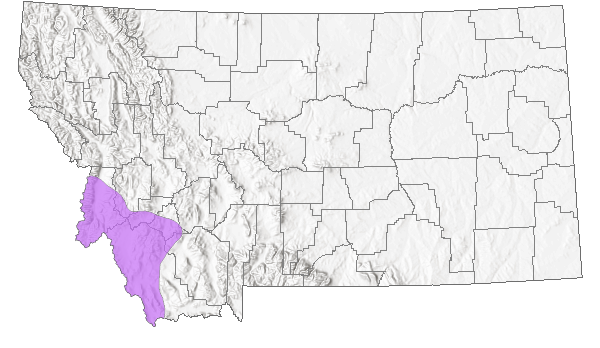
 Native
Native
Range Comments
Regional endemic of Lemhi county, Idaho; and Beaverhead, Deer Lodge, Ravalli and Silverbow counties, Montana.
Observations in Montana Natural Heritage Program Database
Number of Observations: 636
(Click on the following maps and charts to see full sized version)
Map Help and Descriptions
Relative Density
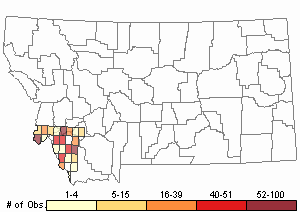
Recency
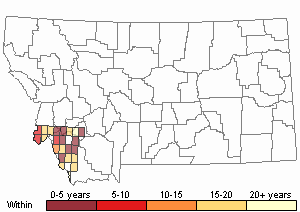
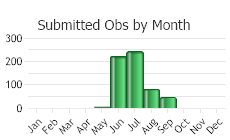
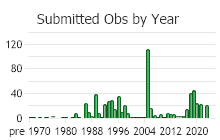
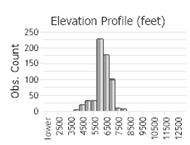 (Observations spanning multiple months or years are excluded from time charts)
(Observations spanning multiple months or years are excluded from time charts)
Habitat
In Montana, Lemhi beardtongue occurs on moderate to steep, east- to southwest-facing slopes, often on open soils. In Beaverhead County, it generally grows below or near the lower extent of Douglas-fir and/or lodgepole pine forest, in habitat dominated by big sagebrush and bunchgrasses, including western wheatgrass and Idaho fescue. Within these habitats, Lemhi beardtongue prefers areas that are more sparsely vegetated (Shelly 1990). In the northeastern Pioneer Mountains, it inhabits forb-dominated openings in lodgepole pine and to a lesser extent Douglas-fir forest; big sage is typically not present, and prominent forbs include Astragalus miser, Pedicularis contorta and Townsendia parryi.
The species is not restricted to any particular geological substrate, and has been found on granitic soils as well as limestone and other sedimentary substrates. Soils are often very gravelly, however soil texture is highly variable and ranges from sand to fine clay. Field surveys from 1986-1989 indicate that it is most commonly found on gravelly loams. Some populations grow partially or entirely on roadbanks.
National Vegetation Classification System Groups Associated with this Species
Shrubland
Sagebrush Shrubland
Grassland
Lowland - Prairie Grassland
Montane - Subalpine Grassland
Ecology
Lemhi beardtongue has some degree of adaptation to natural disturbance, as evidenced by its preference for more open habitats such as rock outcrops and steep, rocky slopes with natural soil slippage (Shelly 1990). This adaptation is underscored where plants have colonized roadbanks.
Studies have shown that seed germination and recruitment are the most critical life history stages (Heidel and Shelly 2001). In general, both flowering and germination are higher in years when spring and early summer are cool and wet. Mortality of established plants is highest in hot, dry years (Heidel and Shelly 2001). Waxing and waning of populations is expected for native species of successional habitats, like
P. lemhiensis.
POLLINATORSThe Large Pollen Wasp (
Pseudomasaris vespoides) is a specialist pollinator of Lemhi Beardtongue (Stucki et al. 2013). Although flowers of Lemhi Beardtongue can get visited by several insect species, the Large Pollen Wasp is a particularly efficient pollinator. Behaving more like a bee, the Large Pollen Wasp’s body fits perfectly into the flowers of Lemhi Penstemon; as the Large Pollen Wasp feeds on nectar, its body collects pollen. As a result, Lemhi Beardtongue benefits from increased seed production and improved genetic diversity while the Large Pollen Wasp gains necessary pollen to feed its larvae (Starkey 2015).
The following animal species have also been reported as pollinators of this plant species or its genus where their geographic ranges overlap:
Bombus vagans,
Bombus appositus,
Bombus auricomus,
Bombus bifarius,
Bombus centralis,
Bombus fervidus,
Bombus flavifrons,
Bombus frigidus,
Bombus huntii,
Bombus melanopygus,
Bombus mixtus,
Bombus nevadensis,
Bombus rufocinctus,
Bombus sylvicola,
Bombus occidentalis,
Bombus pensylvanicus,
Bombus bimaculatus,
Bombus griseocollis,
Bombus impatiens,
Bombus insularis,
Bombus suckleyi,
Bombus bohemicus, and
Bombus kirbiellus (Macior 1974, Thorp et al. 1983, Bauer 1983, Mayer et al. 2000, Wilson et al. 2010, Colla and Dumesh 2010, Colla et al. 2011, Koch et al. 2012, Pyke et al. 2012, Miller-Struttmann and Galen 2014, Williams et al. 2014, Tripoldi and Szalanski 2015).
Management
Monitoring studies on National Forest and BLM lands in southwest Montana have documented sharp declines in some of the largest populations east of the Continental Divide (Shelly 1990; Achuff 1992). One relatively small monitored population was restricted to roadcut habitat and was similarly in decline. Continued declines were projected in the absence of seed germination and recruitment at part or all of the other three sites. Waxing and waning of populations is expected for native ruderal species such as Penstemon lemhiensis.
Fire suppression has been suggested as a factor in the range-wide decline of Lemhi beardtongue (Moseley et al. 1990). It is thought to increase under certain fire regimes, based on qualitative observations after a wildfire in the Salmon National Forest and monitoring of a prescribed burn in Big Hole National Monument, where it increased for a decade after the burn but disappeared from an adjoining untreated area (Heidel and Shelly 1997). Another monitoring study at Badger Pass found that recruitment increased dramatically after fire treatment, consistent with the tendency of fire-adapted species to emerge from seedbanks when fire removes accumulated litter and reduces competition. Based on these studies, prescribed burning has been recommended where Lemhi beardtongue occupies deep-soil rangeland habitats east of the Continental Divide, which are prone to increasing density of Artemisia tridentata in the absence of fire (Heidel and Shelly 2001).
Spotted knapweed is a widespread invader in this species' habitat, particularly west of the Continental Divide. Where Lemhi beardtongue occurs in the Bitterroot National Forest, management is problematic because of the high potential for noxious weeds to expand after fire (Heidel and Shelly 2001). Although herbicides can be used to control invasives, their effect on pollinators of Lemhi beardtongue is unknown. It is an obligate out-crosser, primarily dependent on insect pollination, and relatively small, isolated populations may already be at a disadvantage in their ability to attract effective pollinators (Shelly 1990). Spotted knapweed has not yet invaded populations in Beaverhead and Silver Bow counties, though it has been observed in nearby areas where it can still be controlled without direct impact to this species. Livestock grazing occurs throughout much of the species' range in southwestern Montana, and monitoring transects have been established to assess its effect on populations. The habitat of Lemhi beardtongue was historically impacted by mining at some locations, and renewed gold mining activity could pose a future threat (Shelly 1990).
Stewardship Responsibility
Threats or Limiting Factors
STATE THREAT SCORE REASON
Reported threats to Montana's populations of Lemhi Beardtongue are those that degrade or destroy its disturbance-dependent habitat (MTNHP Threat Assessment 2021). Noxious plant populations, including severe infestations of Spotted Knapweed (Centaurea stoebe) and Cheatgrass (Bromus tectorum) affect several populations. Chemical herbicide is applied at several populations both to control non-native plants or sagebrush density. Herbicide application likely has negative impacts on Lemhi Beardtongue plants, populations and habitat quality. Livestock trampling and grazing occurs at many populations, and observations indicate that Lemhi Beardtongue flowers are preferred even where diverse forage is available. Fire suppression leading to conifer encroachment is reported at many populations, including one of the most abundant populations. Lemhi Beardtongue requires a natural fire regime, both for habitat maintenance and seed regeneration. Occasional fire is known to increase seed viability, reduce sagebrush canopy, and prevent conifer establishment. Negative impacts from co-occurring threats are potentially amplified by chronic drought, and pose complex management challenges. Concern that prescribed fires at many populations may ultimately lead to noxious plant displacement is credible.
References
- Literature Cited AboveLegend:
 View Online Publication
View Online Publication Bauer, P.J. 1983. Bumblebee pollination relationships on the Beartooth Plateau tundra of Southern Montana. American Journal of Botany. 70(1): 134-144.
Bauer, P.J. 1983. Bumblebee pollination relationships on the Beartooth Plateau tundra of Southern Montana. American Journal of Botany. 70(1): 134-144. Colla, S., L. Richardson, and P. Williams. 2011. Bumble bees of the eastern United States. Washington, DC: USDA Forest Service, Pollinator Partnership. 103 p.
Colla, S., L. Richardson, and P. Williams. 2011. Bumble bees of the eastern United States. Washington, DC: USDA Forest Service, Pollinator Partnership. 103 p. Colla, S.R. and S. Dumesh. 2010. The bumble bees of southern Ontario: notes on natural history and distribution. Journal of the Entomological Society of Ontario 141:39-68.
Colla, S.R. and S. Dumesh. 2010. The bumble bees of southern Ontario: notes on natural history and distribution. Journal of the Entomological Society of Ontario 141:39-68. Koch, J., J. Strange, and P. Williams. 2012. Bumble bees of the western United States. Washington, DC: USDA Forest Service, Pollinator Partnership. 143 p.
Koch, J., J. Strange, and P. Williams. 2012. Bumble bees of the western United States. Washington, DC: USDA Forest Service, Pollinator Partnership. 143 p. Macior, L.M. 1974. Pollination ecology of the Front Range of the Colorado Rocky Mountains. Melanderia 15: 1-59.
Macior, L.M. 1974. Pollination ecology of the Front Range of the Colorado Rocky Mountains. Melanderia 15: 1-59. Mayer, D.F., E.R. Miliczky, B.F. Finnigan, and C.A. Johnson. 2000. The bee fauna (Hymenoptera: Apoidea) of southeastern Washington. Journal of the Entomological Society of British Columbia 97: 25-31.
Mayer, D.F., E.R. Miliczky, B.F. Finnigan, and C.A. Johnson. 2000. The bee fauna (Hymenoptera: Apoidea) of southeastern Washington. Journal of the Entomological Society of British Columbia 97: 25-31. Miller-Struttmann, N.E. and C. Galen. 2014. High-altitude multi-taskers: bumble bee food plant use broadens along an altitudinal productivity gradient. Oecologia 176:1033-1045.
Miller-Struttmann, N.E. and C. Galen. 2014. High-altitude multi-taskers: bumble bee food plant use broadens along an altitudinal productivity gradient. Oecologia 176:1033-1045. MTNHP Threat Assessment. 2021. State Threat Score Assignment and Assessment of Reported Threats from 2006 to 2021 for State-listed Vascular Plants. Botany Program, Montana Natural Heritage Program, Helena, Montana.
MTNHP Threat Assessment. 2021. State Threat Score Assignment and Assessment of Reported Threats from 2006 to 2021 for State-listed Vascular Plants. Botany Program, Montana Natural Heritage Program, Helena, Montana. Pyke, G.H., D.W. Inouye, and J.D. Thomson. 2012. Local geographic distributions of bumble bees near Crested Butte, Colorado: competition and community structure revisited. Environmental Entomology 41(6): 1332-1349.
Pyke, G.H., D.W. Inouye, and J.D. Thomson. 2012. Local geographic distributions of bumble bees near Crested Butte, Colorado: competition and community structure revisited. Environmental Entomology 41(6): 1332-1349. Starkey, P. (ed.). 2015. Featured Creature, Lemhi Penstemon Pollen Wasp (Pseudomasaris vespoides). Upper Columbia Basin Network Basin Bulletin. Volume 9, Issue 1. Winter/Spring.
Starkey, P. (ed.). 2015. Featured Creature, Lemhi Penstemon Pollen Wasp (Pseudomasaris vespoides). Upper Columbia Basin Network Basin Bulletin. Volume 9, Issue 1. Winter/Spring. Stucki, Devin, and T. Rodhouse, J. Lyon, L. Grant. 2013. Natural Resource Conservation in a Cultural Park: Evaluating the Importance of Big Hole National Battlefield to the Endemic Lemhi Penstemon (Penstemon lemhiensis). Natural Areas Journal 33(1): 50-58.
Stucki, Devin, and T. Rodhouse, J. Lyon, L. Grant. 2013. Natural Resource Conservation in a Cultural Park: Evaluating the Importance of Big Hole National Battlefield to the Endemic Lemhi Penstemon (Penstemon lemhiensis). Natural Areas Journal 33(1): 50-58. Thorp, R.W., D.S. Horning, and L.L. Dunning. 1983. Bumble bees and cuckoo bumble bees of California (Hymenoptera: Apidae). Bulletin of the California Insect Survey 23:1-79.
Thorp, R.W., D.S. Horning, and L.L. Dunning. 1983. Bumble bees and cuckoo bumble bees of California (Hymenoptera: Apidae). Bulletin of the California Insect Survey 23:1-79. Tripoldi, A.D. and A.L. Szalanski. 2015. The bumble bees (Hymenoptera: Apidae: Bombus) of Arkansas, fifty years later. Journal of Melittology 50: doi: http://dx.doi.org/10.17161/jom.v0i50.4834
Tripoldi, A.D. and A.L. Szalanski. 2015. The bumble bees (Hymenoptera: Apidae: Bombus) of Arkansas, fifty years later. Journal of Melittology 50: doi: http://dx.doi.org/10.17161/jom.v0i50.4834 Williams, P., R. Thorp, L. Richardson, and S. Colla. 2014. Bumble Bees of North America. Princeton, NJ: Princeton University Press. 208 p.
Williams, P., R. Thorp, L. Richardson, and S. Colla. 2014. Bumble Bees of North America. Princeton, NJ: Princeton University Press. 208 p. Wilson, J.S., L.E. Wilson, L.D. Loftis, and T. Griswold. 2010. The montane bee fauna of north central Washington, USA, with floral associations. Western North American Naturalist 70(2): 198-207.
Wilson, J.S., L.E. Wilson, L.D. Loftis, and T. Griswold. 2010. The montane bee fauna of north central Washington, USA, with floral associations. Western North American Naturalist 70(2): 198-207.
- Additional ReferencesLegend:
 View Online Publication
View Online Publication
Do you know of a citation we're missing? Achuff, P.L. 1992. Demographic monitoring of Penstemon lemhiensis, Dillon Resource Area, Bureau of Land Management: establishment and progress report. Unpublished report for the Bureau of Land Management. Montana Natural Heritage Program, Helena, MT. 11 pp.
Achuff, P.L. 1992. Demographic monitoring of Penstemon lemhiensis, Dillon Resource Area, Bureau of Land Management: establishment and progress report. Unpublished report for the Bureau of Land Management. Montana Natural Heritage Program, Helena, MT. 11 pp. Achuff, P.L. 1992. Demographic monitoring of Penstemon lemhiensis. Unpublished report for the Bureau of Land Management. Montana Natural Heritage Program, Helena, MT. 11 pp.
Achuff, P.L. 1992. Demographic monitoring of Penstemon lemhiensis. Unpublished report for the Bureau of Land Management. Montana Natural Heritage Program, Helena, MT. 11 pp. Achuff, P.L. and J.S. Shelly. 1991. Demographic monitoring of Penstemon lemhiensis, Beaverhead National Forest, 1990 progress report. Unpublished report on file at: Montana Natural Heritage Program, Helena, MT. 34 p.
Achuff, P.L. and J.S. Shelly. 1991. Demographic monitoring of Penstemon lemhiensis, Beaverhead National Forest, 1990 progress report. Unpublished report on file at: Montana Natural Heritage Program, Helena, MT. 34 p. Elzinga, Caryl. 1997. Habitat conservation assessment and conservation strategy - Lemhi penstemon (Penstemon lemhiensis). USDA Forest Service and USDI Bureau of Land Management. 46 pp. + app.
Elzinga, Caryl. 1997. Habitat conservation assessment and conservation strategy - Lemhi penstemon (Penstemon lemhiensis). USDA Forest Service and USDI Bureau of Land Management. 46 pp. + app. Heidel, B.L. and J.S. Shelly. 1993. Demographic monitoring of Penstemon lemhiensis, Dillon Resource Area, Bureau of Land Management: 1992 Progress Report. Unpublished Report to the Bureau of Land Management, Dillon Resource Area. Montana Natural Heritage Program, Helena, Montana. 18 pp.
Heidel, B.L. and J.S. Shelly. 1993. Demographic monitoring of Penstemon lemhiensis, Dillon Resource Area, Bureau of Land Management: 1992 Progress Report. Unpublished Report to the Bureau of Land Management, Dillon Resource Area. Montana Natural Heritage Program, Helena, Montana. 18 pp. Heidel, B.L. and J.S. Shelly. 1997. The effects of fire on Penstemon lemhiensis - monitoring establishment report, 1995 and 1996. Unpublished report to the Beaverhead National Forest and the Bureau of Land Management. Montana Natural Heritage Program, Helena, Montana. 11 pp. plus appendices.
Heidel, B.L. and J.S. Shelly. 1997. The effects of fire on Penstemon lemhiensis - monitoring establishment report, 1995 and 1996. Unpublished report to the Beaverhead National Forest and the Bureau of Land Management. Montana Natural Heritage Program, Helena, Montana. 11 pp. plus appendices. Heidel, B.L. And J.S. Shelly. 1999. The effects of fire on Penstemon lemhiensis: interim monitoring report, 1997 and 1998. Unpublished Report to the Beaverhead-Deerlodge National Forest and the Bureau of Land Management. Montana Natural Heritage Program,
Heidel, B.L. And J.S. Shelly. 1999. The effects of fire on Penstemon lemhiensis: interim monitoring report, 1997 and 1998. Unpublished Report to the Beaverhead-Deerlodge National Forest and the Bureau of Land Management. Montana Natural Heritage Program, Heidel, B.L. and J.S. Shelly. 2001. The effects of fire on Lemhi penstemon (Penstemon lemhiensis)-final monitoring report, 1995-2000. Report to the Beaverhead-Deerlodge National Forest and the Dillon Field Office-Bureau of Land Management. Montana Natural Heritage Program, Helena, Montana. 22 pp. plus appendices.
Heidel, B.L. and J.S. Shelly. 2001. The effects of fire on Lemhi penstemon (Penstemon lemhiensis)-final monitoring report, 1995-2000. Report to the Beaverhead-Deerlodge National Forest and the Dillon Field Office-Bureau of Land Management. Montana Natural Heritage Program, Helena, Montana. 22 pp. plus appendices. Idaho Conservation Data Center. 2000. Penstemon lemhiensis records in biological conservation database, December. Idaho Department of Fish and Game, Boise.
Idaho Conservation Data Center. 2000. Penstemon lemhiensis records in biological conservation database, December. Idaho Department of Fish and Game, Boise. Lesica, P., M.T. Lavin, and P.F. Stickney. 2012. Manual of Montana Vascular Plants. Fort Worth, TX: BRIT Press. viii + 771 p.
Lesica, P., M.T. Lavin, and P.F. Stickney. 2012. Manual of Montana Vascular Plants. Fort Worth, TX: BRIT Press. viii + 771 p. Lesica, P., M.T. Lavin, and P.F. Stickney. 2022. Manual of Montana Vascular Plants, Second Edition. Fort Worth, TX: BRIT Press. viii + 779 p.
Lesica, P., M.T. Lavin, and P.F. Stickney. 2022. Manual of Montana Vascular Plants, Second Edition. Fort Worth, TX: BRIT Press. viii + 779 p. Meyer, S.E. 1996. Apendix A. Penstemon Lemhiensis chilling experiment. Unpublished. In: Heidel, B. and J.S. Shelly 2001. The effects of fire on Lemhi penstemon (Penstemon lemhienis) - final monitoring report, 1995-2001. USDA Forest Service Shrub Sciences
Meyer, S.E. 1996. Apendix A. Penstemon Lemhiensis chilling experiment. Unpublished. In: Heidel, B. and J.S. Shelly 2001. The effects of fire on Lemhi penstemon (Penstemon lemhienis) - final monitoring report, 1995-2001. USDA Forest Service Shrub Sciences Mincemoyer, S. 2005. Surveys of significant plant resources and related vegetation types for the Butte Office of the Bureau of Land Management. Montana Natural Heritage Program, Helena, MT. 11 pp + appendices.
Mincemoyer, S. 2005. Surveys of significant plant resources and related vegetation types for the Butte Office of the Bureau of Land Management. Montana Natural Heritage Program, Helena, MT. 11 pp + appendices. Montana Natural Heritage Program. 2000. Penstemon lemhiensis records in biological conservation database, December. Montana State Library, Helena.
Montana Natural Heritage Program. 2000. Penstemon lemhiensis records in biological conservation database, December. Montana State Library, Helena. Moseley, R. K., M. Mancuso, and J. Hilty. 1990. Field investigation and status survey of Penstemon lemhiensis (Lemhi penstemon) in Idaho. Conservation Data Center, Idaho Department of Fish and Game, Boise. 17 pp. plus appendices.
Moseley, R. K., M. Mancuso, and J. Hilty. 1990. Field investigation and status survey of Penstemon lemhiensis (Lemhi penstemon) in Idaho. Conservation Data Center, Idaho Department of Fish and Game, Boise. 17 pp. plus appendices. Ramstetter, J. 1983. An ecological study of the regional endemic Penstemon lemhiensis (Keck) Keck & Cronq. (Scrophulariaceae). Unpublished thesis, University of Montana, Missoula. 116 pp.
Ramstetter, J. 1983. An ecological study of the regional endemic Penstemon lemhiensis (Keck) Keck & Cronq. (Scrophulariaceae). Unpublished thesis, University of Montana, Missoula. 116 pp. Ramstetter, J. and K.M. Peterson. 1984. Rarity in Penstemon lemhiensis (Keck) Keck & Cronq. In: Abstracts, annual meeting of the Botanical Society of America; 1984 August 5-9; Fort Collins, CO. American Journal of Botany, 71 (5 Part 2):69.
Ramstetter, J. and K.M. Peterson. 1984. Rarity in Penstemon lemhiensis (Keck) Keck & Cronq. In: Abstracts, annual meeting of the Botanical Society of America; 1984 August 5-9; Fort Collins, CO. American Journal of Botany, 71 (5 Part 2):69. Ramstetter, J., and K. M. Peterson. 1984. Pollination biology of Penstemon lemhiensis (Keck) Keck & Cronq. In: Abstracts, Annual meeeting of the Botanical Society of America; 1984 August 5-9; Fort Collins, CO. American Journal of Botany. 71(5 Part 2):87. Abstract.
Ramstetter, J., and K. M. Peterson. 1984. Pollination biology of Penstemon lemhiensis (Keck) Keck & Cronq. In: Abstracts, Annual meeeting of the Botanical Society of America; 1984 August 5-9; Fort Collins, CO. American Journal of Botany. 71(5 Part 2):87. Abstract. Rodhouse, T. J. 2016. Monitoring Lemhi penstemon (Penstemon lemhiensis) and spotted knapweed (Centaurea stoebe) in Big Hole National Battlefield: 2009-2014. Natural Resource Report NPS/UCBN/NRR -- 2016/1143. National Park Service, Fort Collins, CO. 10 p of front matter + 36 pp.
Rodhouse, T. J. 2016. Monitoring Lemhi penstemon (Penstemon lemhiensis) and spotted knapweed (Centaurea stoebe) in Big Hole National Battlefield: 2009-2014. Natural Resource Report NPS/UCBN/NRR -- 2016/1143. National Park Service, Fort Collins, CO. 10 p of front matter + 36 pp. Shelly, J.S. 1987. Status review of Penstemon lemhiensis, U.S. Forest Service - Region 1, Beaverhead and Bitterroot National Forests, Montana. Unpublished report. 67 pp.
Shelly, J.S. 1987. Status review of Penstemon lemhiensis, U.S. Forest Service - Region 1, Beaverhead and Bitterroot National Forests, Montana. Unpublished report. 67 pp. Shelly, J.S. 1990. Report on the conservation status of Penstemon lemhiensis, a candidate threatened species: Montana. Montana Natural Heritage Program, Helena. 89 pp.
Shelly, J.S. 1990. Report on the conservation status of Penstemon lemhiensis, a candidate threatened species: Montana. Montana Natural Heritage Program, Helena. 89 pp. Shelly, J.S. 1990. Status review update and establishment of demographic monitoring studies: Penstemon lemhiensis. Prepared for U.S. Department of Agriculture, Forest Service - Region 1, Beaverhead and Bitterroot National Forests, Montana. 61 pp.
Shelly, J.S. 1990. Status review update and establishment of demographic monitoring studies: Penstemon lemhiensis. Prepared for U.S. Department of Agriculture, Forest Service - Region 1, Beaverhead and Bitterroot National Forests, Montana. 61 pp. Shelly, J.S. And B.L. Heidel. 1993. Demographic Monitoring of Penstemon Lemhiensis in the Beaverhead National Forest, 1992 Progress Report. Montana Natural Heritage Program, Helena, Mt. 15 Pp.
Shelly, J.S. And B.L. Heidel. 1993. Demographic Monitoring of Penstemon Lemhiensis in the Beaverhead National Forest, 1992 Progress Report. Montana Natural Heritage Program, Helena, Mt. 15 Pp. Shelly, J.S. and B.L. Heidel. 1995. Demographic monitoring of Penstemon lemhiensis in southwest Montana - final report. Unpublished report to the Beaverhead National Forest and the Bureau of Land Management. Montana Natural Heritage Program 26 pp. plus appendices.
Shelly, J.S. and B.L. Heidel. 1995. Demographic monitoring of Penstemon lemhiensis in southwest Montana - final report. Unpublished report to the Beaverhead National Forest and the Bureau of Land Management. Montana Natural Heritage Program 26 pp. plus appendices. Shelly, J.S. And P.L. Achuff. 1992. Demographic Monitoring of Penstemon lemhiensis, Beaverhead National Forest: 1991 Progress Report. Unpublished Report to the Beaverhead National Forest, Montana. Montana Natural Heritage Program, Helena, Mt. 19 Pp.
Shelly, J.S. And P.L. Achuff. 1992. Demographic Monitoring of Penstemon lemhiensis, Beaverhead National Forest: 1991 Progress Report. Unpublished Report to the Beaverhead National Forest, Montana. Montana Natural Heritage Program, Helena, Mt. 19 Pp. Strickler, D. 1997. Northwest penstemons. Flower Press, Columbia Falls, Montana. 191 pages.
Strickler, D. 1997. Northwest penstemons. Flower Press, Columbia Falls, Montana. 191 pages.
- Web Search Engines for Articles on "Lemhi Beardtongue"





